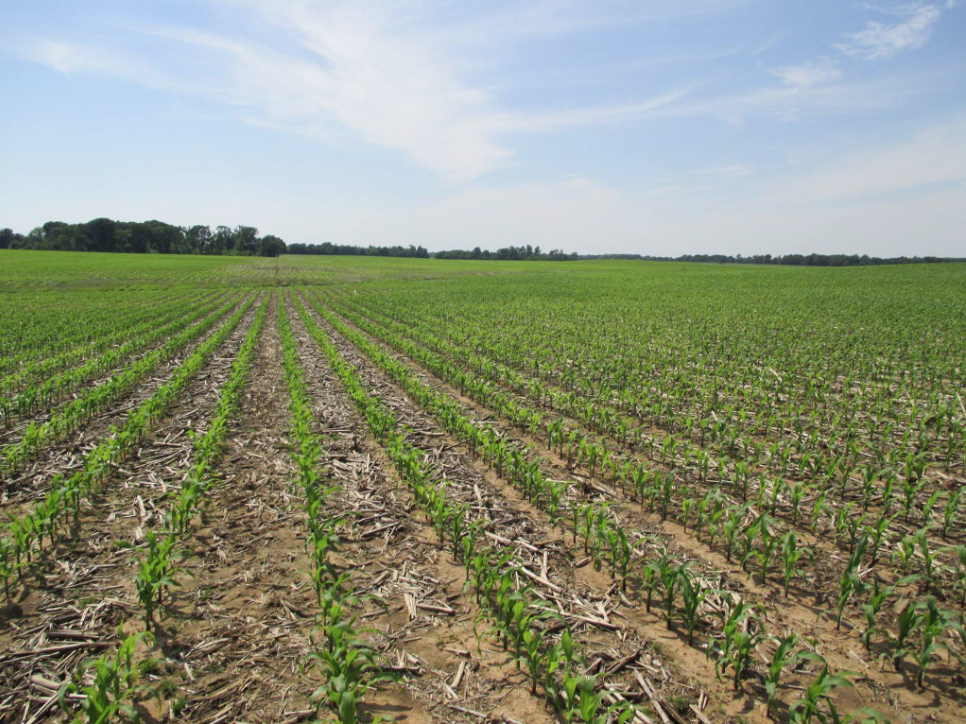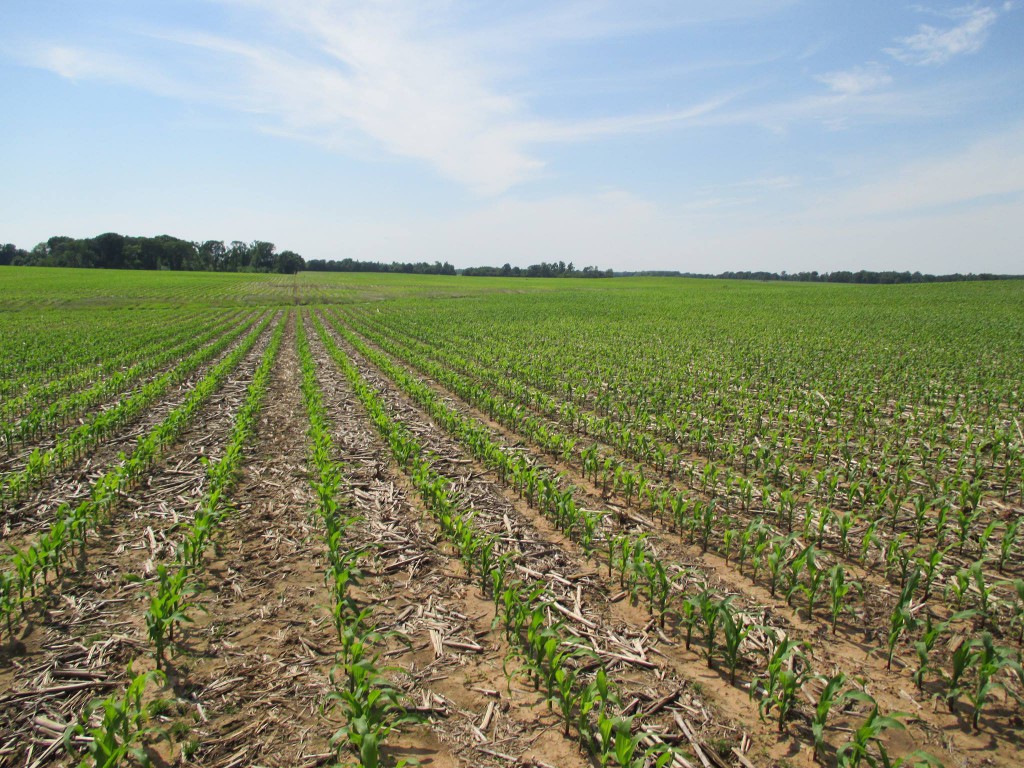By David Hall, Sarah Beth Thompson, Wesley Porter

This post was developed by David Hall and I appreciate him taking the time to put his thoughts, experiences, and observations from this season into this blog post.
After a conversation with a local crop consultant regarding irrigation scheduling, the wheels in my mind really started moving. The consultant stated that a producer who uses soil moisture sensors was questioning if he irrigated too much? By observations and conversations with a neighbor, he was informed that some of his fields this year were yielding the same or less than the neighbors fields that had lower amounts of irrigation applied, in addition to some dryland fields with similar or higher yields. There is no doubt that dryland yields and yields from lower irrigation amounts can exceed amply irrigated yields in certain years. Dr. Porter’s research over the years has a few years in which a dryland crop in the same field can out yield or equal irrigated yield using soil moisture sensors for scheduling events. How could this be so? The weather is unpredictable and can vary so much from year to year. I personally believe there are several answers that have many variables that may help explain the phenomenon. Fertility, planting dates, crop variety, soil type, insect or disease pressure and rainfall intensities along with frequencies can all play a part in yields of dryland outperforming irrigated land.
I believe we overlook fertility in many cases. Most times we fertilize the entire field for optimum yields, but in many years the dryland struggles with lack of moisture and therefore the plants do not remove as much fertilizer from the soil. It’s possible to have higher levels of fertility in those dryland areas from the number of dry years and lower uptake of nutrients. Variable rate fertilizer applications can help with this, but if your standard procedure is two tons of litter or treating both areas the same each year, fertility levels could be increasing in the dryland. The irrigated land provides moisture and greater fertilizer uptake by the plants. If we have rain as we’ve had this past year, leaching can occur on those wetter irrigated soils and the dryland that perhaps had higher levels of nutrients can tolerate losing more. This is most noticeable in cotton when we see potash deficiencies in our irrigated cotton, while the dryland corners of the same field show no symptoms. Although the dryland received less total water in inches, it did receive beneficial rainfall amounts and did not lack nutrients leading to possible greater yields.
After keeping accurate rainfall and irrigation event records on a peanut field of mine, I really took a close look at each event. They say hindsight is 20/20. In this field, variety was the same, and the dryland was treated exactly like irrigated, except irrigation of course. The dryland corners did in fact outyield my irrigated land by several hundred pounds. There are obvious reasons for this occurrence after reflecting. First, there were 4-5 acres of extreme sandy soil in the irrigated field that had to have terraces and washes fixed from Hurricane Helene. Lime was applied according to soil samples in these areas, but the weakness in the peanuts was visible. Next, I looked at rainfall vs. irrigated events. The field received 15.8 inches of rain while I applied 5.7 inches of irrigation via recommendations of a moisture sensor. I can’t stress enough the importance of properly timed watering events and the intensity at which it is received. The peak water demand for these peanuts was during the month of August. I had zero irrigation events during August! Rainfall was sufficient and cooler temperatures provided ideal conditions for pegging and the filling of pods. So, when did I apply the 5.7 inches of irrigation, and was it too much or a waste of money? Looking at the dates, most irrigation events were triggered during late June and all of July. During four irrigation events where I applied 0.6-0.7 inches of irrigation, my sensor was calling for moisture, and I remember the chances of rain were hit or miss, therefore I irrigated the field. On each of those four events, within two days I received as much or more rainfall than what I applied by irrigation. Did I waste water and money? The answer looking back is yes, but I was not willing to miss a shower and get behind on irrigation scheduling. It’s extremely hard if not impossible to catch up with irrigation when moisture is low and heat is very high. The intensity of irrigation application and rainfall should also be considered when we are discussing this topic. Irrigation is applied at a very high intensity compared to most rainfall events, leading to a higher infiltration rate of rainfall in most cases. This oftentimes makes the rainfall seem more effective at sub-soil moisture replenishment. So again, if there is no guarantee of rainfall, it could be beyond detrimental to skip an irrigation event and deplete deep moisture further.
Figuring roughly, the irrigation events cost me 25 dollars per acre in electricity. I can’t put a dollar figure on potential yield loss if I had not irrigated, and the predicted rains never came, and I fell behind on watering the crop. As I said, the dryland outyielded the irrigated land plus I had over irrigated, but not intentionally. I chose to spend the money on irrigation events in anticipation of no rainfall. It was a tradeoff that I was willing to make. An important note is that the dryland grades averaged 68 while the irrigated land averaged 75 grades, all in the same field. This will increase the value of the irrigated peanuts. Plus, do not forget the 4-5 acres of marginal land in the irrigated portion. I think when it comes to triggering irrigation, one must take into consideration how long it will take to apply the moisture needed and your willingness to wait on a possible 50-50 chance of rainfall. This is a call a producer must feel good about and live with. I believe that a large part of our overwatering in an average to above average rainfall year, while using some sort of irrigation scheduling such as moisture sensors, can come from the just mentioned real life scenario. Another way of excessive watering is by not utilizing the full profile of available moisture before triggering an irrigation event. On that same note, I have witnessed many times producers do actually apply more water than the soil can handle, which shows up on a sensor reading with drastic drops after an irrigation event. Sometimes it’s not possible to wait until a sensor triggers an irrigation event because of the lack of needed flowrate from the pump and irrigation system capacity. One must start the system prior to hitting the trigger level to make the entire application in a timely fashion. Looking back on this field, I probably could have been fine with 3 inches of irrigation and addressing the fertility issue more aggressively in the irrigated mentioned land. The neighbor that gambled on rainfall may look good this year, but I’d be willing to bet that over a period, you will come out better by conducting irrigation scheduling as called for.
A notable fact is when we get beneficial rainfall that allows for infiltration and instant cool downs of the canopy and soil, the moisture is used more efficiently than irrigation because of uniformity and lower ET rates. There is a reason why we say there is nothing like good timely rain. It’s free and efficient when it comes at a gentle rate! Rain is a blessing, but in most years, we need supplemental irrigation to achieve a crop’s potential. I will stand by Dr. Porter’s research and say firmly that if you irrigate your crops by a reliable scheduling method such as moisture sensors, and trigger irrigation events at recommend levels, over a five-year period you will prevail with higher average yields from irrigated fields vs. dryland and greater returns even if you think you wasted money overwatering a crop in some years. I will state for the record that also holding off a needed irrigation event while “betting on a marginal rain chance” in the next few days away is just that, you are gambling. Farming is gambling in a sense but one must do it with much educated planning from sound proven research. Irrigation scheduling is to be conducted and treated the same way.
